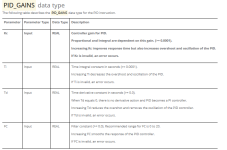Hey Peter.
Thank you for the feedback.
I am not very clever, but I am good with numbers, so rest assured that the central points I made in that post are, I am fairly confident, correct; I will try to resolve your misunderstandings below. That said, I am more than willing to be proved wrong to advance knowledge. So sharpen your pencil ...
The title of that post was "
Reverse engineering of the CCW PID instruction." I invite anyone with the time to duplicate my experiments; nothing like the scientific method; if the PID instruction implemented in the CCW Micro850 simulator, then all the relevant software should be freebies.
TL;DR
... That is not a gain. I think you got the FC and Td terms mixed up. ...
Really? Then why does the PV step of -100k, with Kc = 0.1 and FC = 4.0, generate a step of 50k (= 10k[P] + 40k[D]) in the Micro820 v12 PID instruction's CV with a ∆t of 1s? And if I halve that FC, to 2.0, the CV step is 30k (= 10k[P] + 20k[D]).
Do the math: 40k = [
0.1 * 4.0 * 100k] = [
Kc * FC * -∆PV]; don't assu...
Whoops, too late

.
Yes,
- @Peter Nachtwey is assuming the poorly-written CCW documentation is correct and the names of the PID_GAINS object for the Micro820 v12 PID instruction follow the canonical convention;
- I have measured and reverse-engineered that PID instructions behavior as a synthetic, but (somewhat) deterministic, process, and found a model that is accurate to all five significant digits available in the measurement technique employed.
Who is more likely to be right (that's not rhetorical; measurement is never easy

)?
That said, I stand by my statements (except for forgetting to label the abscissa), and am confident that what I posted is correct; Peter has merely not grokked it yet.
Why does Td have units of s**2?
- λ is the time constant of an exponential decay process
- This is verified by reverse engineering and measureing the behavior, accurate to 5 significant figures, of the Micro820 v12 PID instruction's derivative term after a step change in PV
- Therefore the units of λ are time, in this case seconds
- λ = Td/FC
- Again, verified by reverse engineering and measuring
- The units of FC are seconds
- The quantity FC in the Micro820 v12 PID is what is usually called Td in the canonical PID formula
- ∴, Td = λ FC
- ∴, the units of Td are s*s => s**2
At the bottom you have 1-exp(-2s/lambda*s)
What is lambda?
[Update: in the post that denominator of the exponent is "λs" not "λ*s;" the "s" was a clumsy attempt to express the units of λ]
Arrgh, should have used τ, although then there might be confusion with deadtime. Anyway, λ is the time constant of an exponential decay process (I am sure that is obvious from that formula, but I want to state it explicitly). Also,
λ = Td/FC
So, in the example shown in
previous post #8:
λ = (2.6667 / 4.0) = (2/3)s
@drbitboy, there is no time on the axis x on your charts.
Ouch, yes, my bad, I meant, but forgot, to put a pair of dimensional arrows indicating the scale of 1s; however note that ∆t is 1s (cf. annotation in lower right), and know that the visible steps of the CV decay therfore occur at intervals of 1s (∆t); also note the annotation. (3) and (4), of the time of each decay step.
P.S. I feel like Captain Queeg: "They laughed at me and made jokes, but I proved beyond the shadow of a doubt and with - geometric logic
..."





